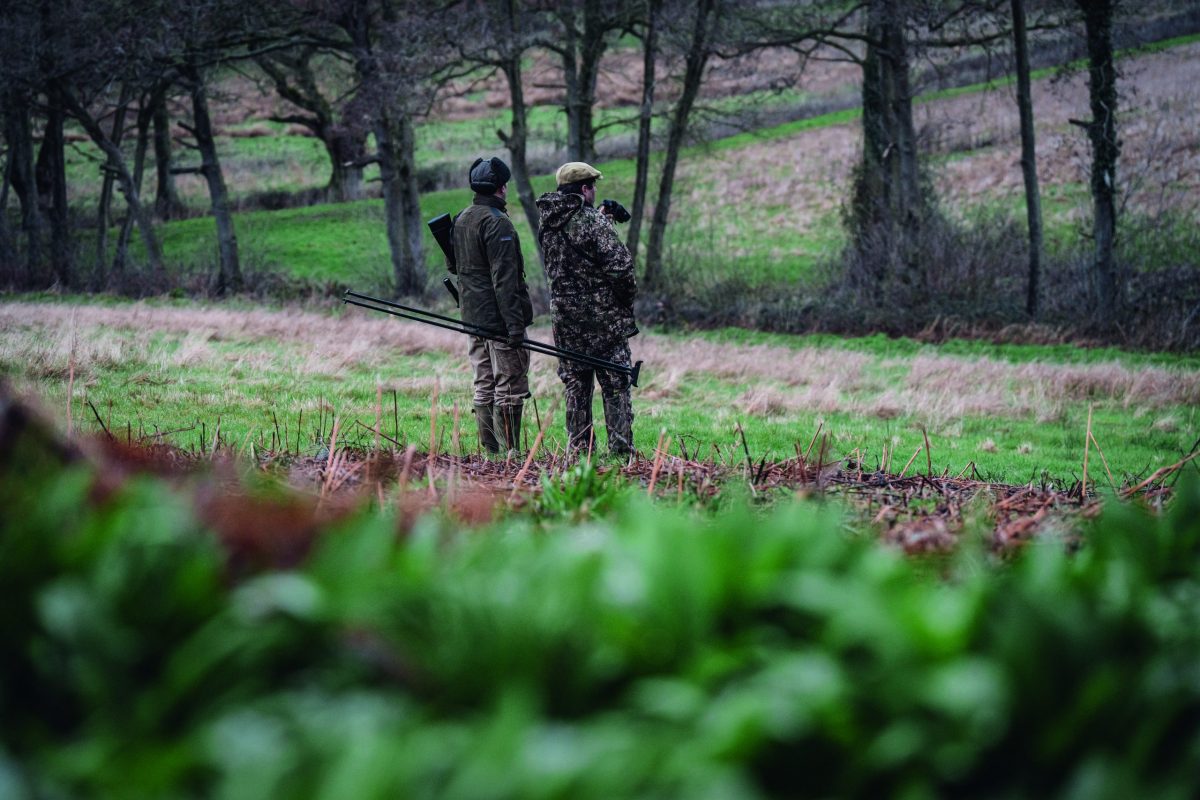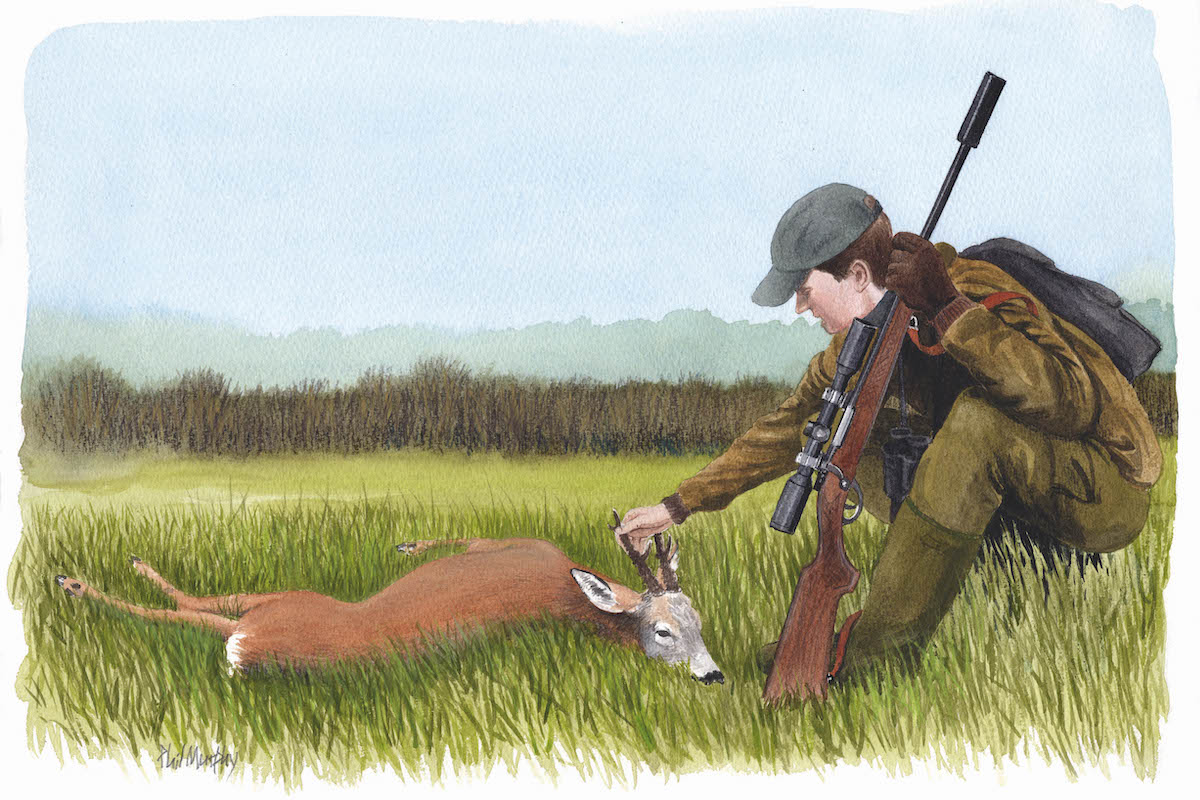First roebuck stalk – the lessons to be learned
As the roebuck season opens, Miles Malone takes a novice stalker out on a mission to shoot his first beast, a big step forward

Miles Malone and Alex study the ground, looking for deer that will fit the cull plan
On an early spring morning, three of us met to stalk. Ben would be making his way to a high tower to wait for deer emerging, while I guided Alex, who is relatively new to stalking. Providing one-on-one mentoring would help build his experience and, critically, confidence.
There is a great step change between what is learned on DSC1 (deerstalking certificate), an introductory course, and the expectations of the DSC2 assessment, in which the candidate is required to lead a stalk and complete all components, from stepping out of the vehicle to hanging the beast in the chiller.
Preparatory stalks, such as these, are crucial to build the necessary skills and experience for this important advance in the deer
manager’s progression.
We carefully made our way along the woodland edge, positioning ourselves to glass the valley below. The roebuck season had just opened and we were in pursuit of cull bucks and the ever-increasing population of muntjac. Our job here is to limit population growth, protecting young plantations and coppice woodland from the destructive effects of browsing and fraying.

The rifle is set on sticks, ready to take the shot if the animal presents itself
Hunker down
The weather had turned. A cold north-westerly and intermittent showers were due; I thought it likely the roe would hunker down in the low ground, sheltering from the biting wind. The muntjac, never a fan of the cold and wet in combination, having originated from warmer climes, would likely remain in the thicker woodland. Perhaps they would venture out between showers, favouring the easterly edge of the wood, to soak up the sunshine if it managed to break through.
Sure enough, we spotted some roe almost immediately in the sheltered valley. It was still too dark to make out their sex or age at this distance, so we planned our route to get nearer, checking the wind as we went. We did not get far. A shot was heard far to our left, the sound of the rifle overlapping with the solid thump of impact; Ben had clearly had early success.
The roe lifted their heads to stare in the direction of the shot. Not overly disturbed, they sauntered upwind past the hedge line and began feeding again in the field beyond.
Pressing on, we followed a hedge, taking care not to skyline ourselves. As the light levels increased, we deliberately slowed. Wherever possible, we kept foliage between ourselves and the deer, staying in single file to limit our outline.

The deer are wary, hugging the edge of the woodland
Spindly
We matched our movements to the deer’s behaviour; as they periodically lifted their heads from feeding, we froze, moving on once they settled again. The increasing light and the shortening distance let us identify the first two as does, likely a mature doe and her following female youngster. Behind some distance, we could now make out the third as a young buck, probably in his second year, with a narrow and uneven four-point head, set upon spindly coronets; a clear candidate for the cull plan.
We made it to an alder carr, thick with wild garlic, the scent carried downwind to us; herbal, savoury and lush. In another 20 minutes, we would be in the dead ground and, hopefully, positioned for a straightforward final approach for a shot.
Managing deer in high-population areas has the benefit of presenting many opportunities, but it also means there are many pairs of eyes on the lookout.
A concealed roe doe, unbeknown to us, was couched among the wild garlic fronds. In the dead ground of the sheltered wood, we could not have spotted her nor indeed picked up a heat signature on the thermal imager. She bolted, not 30m away, grunting as she went, descending to the valley below, bringing the other three with her, white tails bobbing into the far distance.
We waited a while to let things calm. Eventually the chorus of roe grunts subsided, the birdsong resumed and the melodic cooing of pigeons filled the brightening day.
Negotiating a reed-fringed ditch, we climbed the shallow hill ahead to spy out the next undulation, hoping to find deer undisturbed by the noisy events. A heat signature appeared
in the distant tree line. Switching to binoculars, we saw a muntjac doe emerging, passing through the wispy grass and around bramble patches, into the open. The rifle was mounted on to the sticks, carefully positioning for the chance of a shot as the small deer closed the distance between us.

Miles and Alex discuss tactics; there are certainly deer about, given away by fresh slots (below)

Pregnant
A careful study showed no following fawn; she was a mature doe and looked bulky on the abdomen, so likely pregnant. She was a good cull animal to choose, safe in the knowledge that no dependent fawn would be left to fend for itself.
The muntjac came closer still, but then veered from her original route, climbing the slope ahead of us. In hushed tones I discussed safe backdrops with Alex. This deer was too near the crest of the slope and did not have the requisite safe ‘bullet-catching’ ground behind to enable
a shot to be taken.
The muntjac continued, oblivious to our presence, finally departing into the wood line. The tense moment of expectation passed, the mood drifted towards disappointment as another opportunity narrowly escaped us. But it did provide an essential learning opportunity; a shot fired without a safe backdrop could lead to catastrophic consequences.
Further ahead, we spied more heat signatures in the woodland edge. A stealthy approach with an abundance of cover to conceal us meant we could get close. Among the hazel a roe doe could be seen, but further to the left a smaller outline became visible. We could see the tips of the small spikes of a young muntjac buck. Alex focused on the deer through his scope while I studied through the binoculars.
The buck was gradually moving through the undergrowth unrushed, browsing as he went. Frustratingly, a thin screen of branches and foliage always covered his chest, and no
shot was possible. He eventually wandered out of sight, consumed by the dense undergrowth.
Another close opportunity and another valuable lesson; even the thinnest twig can deflect a round, risking an injured animal or turning what initially appeared a safe shot into
a dangerous one.
After this third opportunity without a shot, with time pressing on, we wondered if today luck would not be with us. We decided to stalk the downwind side of the next copse then call it a day. It was with relief that, halfway along the wood line, we watched a roebuck step out to browse the bramble edge. The buck, mature yet a poor specimen, qualified for the cull plan.
Alex quietly adjusted his sticks and placed his rifle, waiting for the buck to turn slightly, presenting broadside for the shot. Something must have caught the buck’s eye, for suddenly he tilted his head, staring intently in our direction. He moved his head from side to side to try to focus on this perceived danger. He must have seen us, for he bolted out into the field. Thankfully, he suddenly stopped, apparently confused, then stepped forward and tried to focus in our direction. Alex aligned the sticks with to the new position and we checked the new backdrop, which was safe.
I whispered: “Take the shot if you are comfortable.” And the moderated crack of the .308 sounded, the buck falling instantly, laying motionless in the young wheat crop.
Lifeless
After a five-minute wait spent watching the buck, which lay lifeless, we approached and confirmed the deer was dead by testing the corneal reflex with the shooting sticks. This, Alex’s first roebuck, had fallen instantly to a well-placed shot. Now the work would begin; extraction, inspection, gralloch and finally to the chiller, tagged and ready for the gamedealer. We met Ben, who had been successful in the high seat, harvesting a muntjac buck. Both deer were destined for the diner’s plate.
Now was time to reflect, coffee in hand, upon the morning’s events; of a challenging stalk, with opportunities beyond reach, of fleeting chances and lessons learned. Not a destination in themselves, deer qualifications are important stepping-stones in the deer manager’s journey. Nothing will beat time in the field for preparation, not only for gaining DSC2 but for a lifetime of safe, successful stalking.








